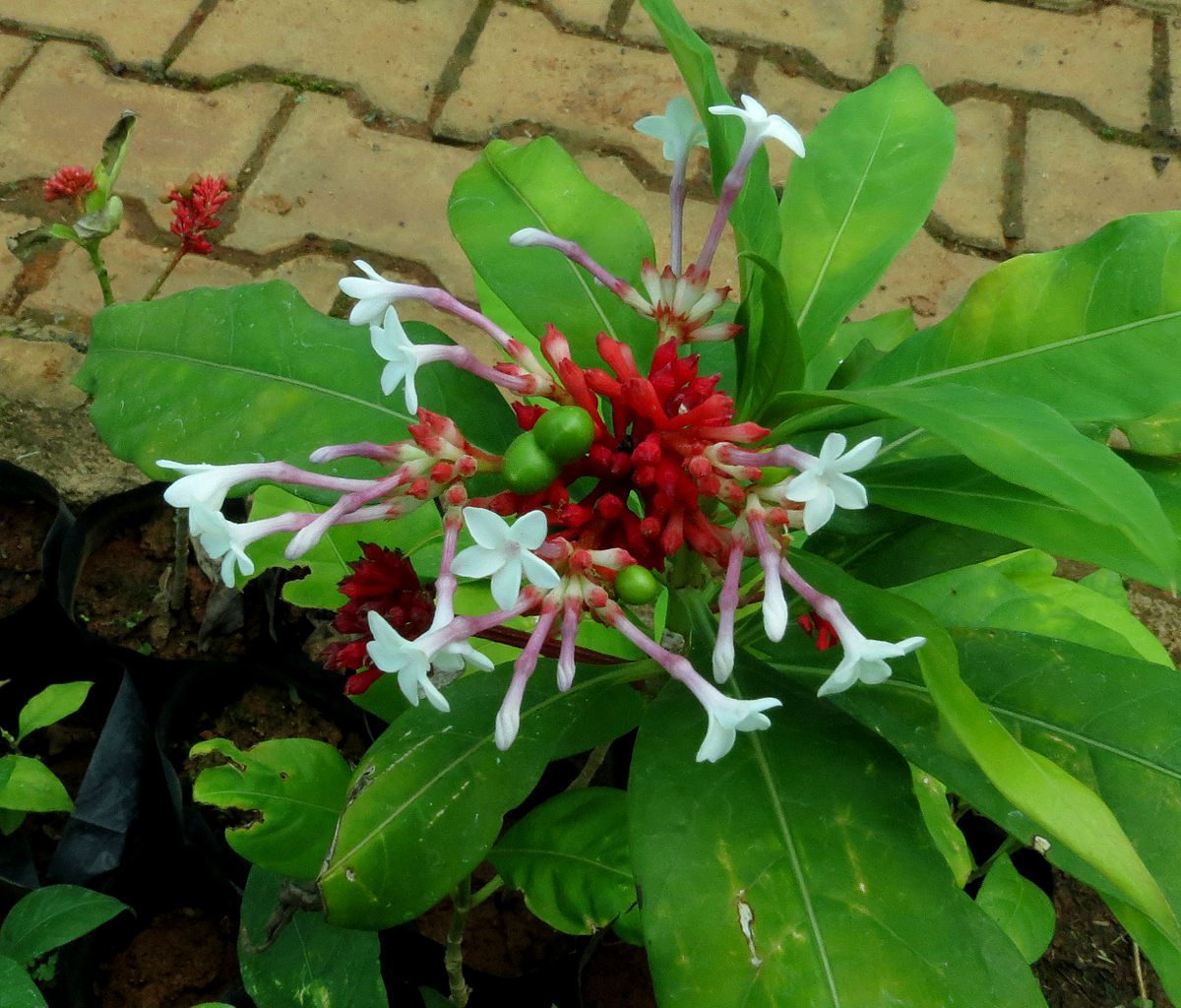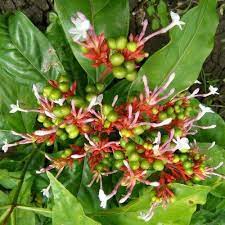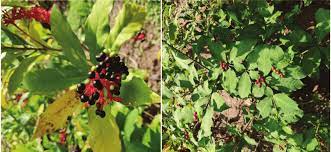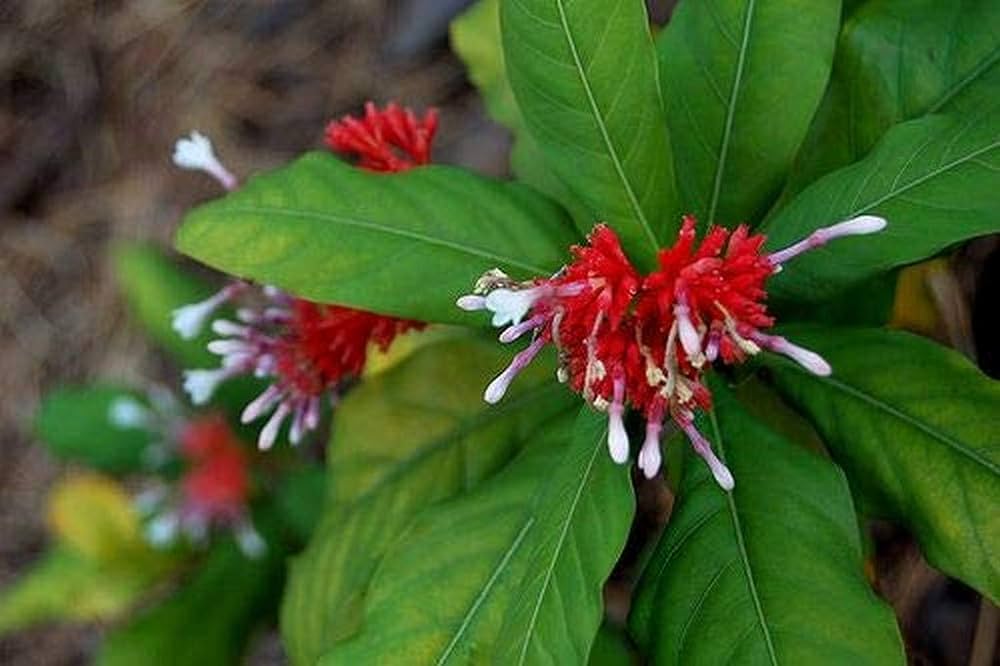Rauvolfia serpentina, commonly known as Indian Snakeroot, is a perennial woody shrub native to the Indian subcontinent and Southeast Asia. It belongs to the Apocynaceae family and is characterized by its slender stems, glossy green leaves, and small white or pink flowers.
Indian Snakeroot is a valued medicinal plant with a long history of use in traditional Ayurvedic and Unani medicine systems. It contains a group of alkaloids, including reserpine, ajmaline, and serpentine, which are concentrated in its roots and stems and are responsible for its therapeutic effects.
One of the primary uses of Rauvolfia serpentina is in the treatment of hypertension (high blood pressure). The alkaloids found in the plant have been shown to have hypotensive (blood pressure-lowering) effects by inhibiting the activity of certain neurotransmitters in the brain. This action helps to relax blood vessels and reduce the overall resistance to blood flow, thereby lowering blood pressure levels.
In addition to its antihypertensive properties, Indian Snakeroot is also valued for its sedative and tranquilizing effects. It has been used traditionally to calm the nervous system, alleviate anxiety, and promote relaxation. These properties make it useful in the management of conditions such as insomnia, stress, and nervousness.
Furthermore, Rauvolfia serpentina has been studied for its potential antiarrhythmic effects, meaning it may help regulate abnormal heart rhythms. This makes it potentially useful in the treatment of certain cardiac conditions, although further research is needed to fully understand its mechanisms of action and clinical applications in this regard.
Indian Snakeroot is typically prepared as a decoction or infusion, with the dried roots or stems being steeped in hot water to extract their medicinal compounds. It can also be found in powdered or capsule form for convenience.
While Rauvolfia serpentina has demonstrated promising medicinal properties, it should be used with caution and under the guidance of a qualified healthcare practitioner, especially in cases of hypertension or cardiovascular disease. Excessive or prolonged use of the plant may lead to adverse effects such as hypotension (low blood pressure) or central nervous system depression.
The Botanical Description of Rauvolfia serpentina
1. Life: Rauvolfia serpentina, commonly known as Indian Snakeroot or Sarpagandha, is a perennial, evergreen shrub belonging to the Apocynaceae family.
2. Size and Structure: This plant typically grows to a height of 60-150 cm, with a straight stem and numerous branches. The leaves are arranged in whorls, and the plant produces small, tubular flowers.
3. Leaves: The leaves are elliptical, dark green, and glossy. They are leathery in texture and have a prominent central vein.
4. Flowers: Rauvolfia serpentina blooms with small, funnel-shaped flowers that are fragrant and arranged in clusters. The color of the flowers varies from white to pink.
5. Fruits: The plant produces small, fleshy fruits that are red or orange when ripe. These fruits contain seeds and contribute to the plant’s reproduction.
6. Roots: The root system of Rauvolfia serpentina is well-developed, with a thick, fleshy, and aromatic root. It is the part of the plant commonly used for medicinal purposes.
7. Bark: The bark is smooth and grayish-brown in color, providing additional botanical characteristics for identification.
8. Habitat: Rauvolfia serpentina is native to the Indian subcontinent and thrives in tropical and subtropical regions. It is often found in the hilly areas of India, Nepal, and Sri Lanka.
9. Growing Conditions: This plant prefers well-drained soil and partial shade. It is adapted to diverse ecological conditions, making it resilient in various habitats.
10. Reproductive Strategy: Rauvolfia serpentina reproduces both sexually, through the production of seeds in its fruits, and asexually, through vegetative propagation from its root system.
11. Aromatic Qualities: The roots of Rauvolfia serpentina are highly aromatic, emitting a distinct odor due to the presence of alkaloids.
12. Cultivation: Given its medicinal significance, Rauvolfia serpentina is cultivated for commercial purposes, ensuring a sustainable supply for herbal medicine production.
The Geographic Distribution of Rauvolfia serpentina

1. Native Regions: Rauvolfia serpentina is native to the Indian subcontinent, primarily found in countries such as India, Nepal, and Sri Lanka.
2. Natural Habitats: This plant thrives in a variety of habitats, including the Himalayan foothills, deciduous forests, and areas with well-drained soils.
3. Global Distribution: Due to its medicinal importance, Rauvolfia serpentina has been introduced and cultivated in various tropical and subtropical regions worldwide.
4. Cultivation in Other Countries: Apart from its native regions, it is cultivated in countries like Indonesia, Malaysia, and some parts of Africa to meet the demand for its medicinal properties.
5. Altitude Range: Rauvolfia serpentina is often found at altitudes ranging from 400 to 1,200 meters above sea level.
6. Climate Preference: It thrives in tropical climates with warm temperatures and high humidity.
7. Adaptability: The plant shows adaptability to different soil types, including sandy and loamy soils, enhancing its distribution across varied landscapes.
8. Human Interventions: Human cultivation and intentional introduction have expanded the geographic range of Rauvolfia serpentina beyond its natural habitats.
9. Conservation Status: Due to extensive harvesting for medicinal use, there is a need for conservation efforts to ensure the sustainability of Rauvolfia serpentina populations in the wild.
10. Traditional Knowledge: Indigenous communities in its native regions often possess valuable traditional knowledge about the plant’s habitat, growth conditions, and sustainable harvesting practices.
11. Environmental Impact: Introducing Rauvolfia serpentina to new regions should be done cautiously, considering potential ecological impacts and the preservation of native flora.
12. Research Initiatives: Ongoing research is essential to understand the ecological dynamics of Rauvolfia serpentina in both its native and introduced habitats.
13. Global Demand: The increasing global demand for herbal medicine has led to expanded cultivation, emphasizing the importance of sustainable practices.
14. Biodiversity Contribution: Rauvolfia serpentina, as a native species, contributes to the biodiversity of its natural habitats, supporting local ecosystems.
The Chemical Composition of Rauvolfia serpentina
1. Alkaloids: Rauvolfia serpentina is renowned for its alkaloid content, including prominent compounds like reserpine, ajmaline, serpentine, and yohimbine.
2. Reserpine: This alkaloid is a key component with antihypertensive and tranquilizing properties, making Rauvolfia serpentina significant in traditional medicine.
3. Ajmaline: Known for its antiarrhythmic effects, ajmaline contributes to the plant’s cardiovascular benefits.
4. Serpentine: Exhibiting antihypertensive properties, serpentine complements the overall medicinal profile of Rauvolfia serpentina.
5. Yohimbine: Another alkaloid, yohimbine, has been studied for its potential in treating erectile dysfunction and as an aphrodisiac.
6. Indole Alkaloids: Various indole alkaloids present in the plant contribute to its pharmacological effects, including sedative and antihypertensive actions.
7. Tannins: Rauvolfia serpentina contains tannins, which contribute to its astringent properties and potential antioxidant effects.
8. Flavonoids: These compounds add to the plant’s antioxidant capacity and may have anti-inflammatory and immune-modulating properties.
9. Saponins: Saponins, found in Rauvolfia serpentina, are known for their surfactant properties and may contribute to its traditional uses.
10. Beta-Carboline Alkaloids: These alkaloids have been investigated for their neuroprotective and antioxidant properties.
11. Essential Oils: The roots of Rauvolfia serpentina contain essential oils, adding to its aromatic qualities and potential therapeutic benefits.
12. Glycosides: Presence of glycosides in the plant may contribute to its cardiovascular effects and overall medicinal actions.
13. Coumarins: Coumarins, though present in smaller quantities, may contribute to the plant’s pharmacological profile.
14. Sterols: Sterols, including beta-sitosterol, are part of the plant’s chemical composition and may have cholesterol-lowering effects.
Read Also: 15 Medicinal Health Benefits of Salvia yangii (Russian Sage)
The Medicinal Health Benefits Of Rauvolfia serpentina (Indian Snakeroot)

1. Hypertension Management: Rauvolfia serpentina is renowned for its antihypertensive properties, attributed to reserpine. It helps regulate blood pressure and is used in traditional medicine for hypertension management.
3. Anxiety Relief: The tranquilizing effects of Rauvolfia serpentina make it valuable in alleviating symptoms of anxiety and promoting relaxation.
4. Antidepressant Properties: Compounds found in Rauvolfia serpentina may have mood-enhancing effects, making it beneficial in managing symptoms of depression.
5. Anticonvulsant Activity: Research suggests that Rauvolfia serpentina exhibits anticonvulsant properties, potentially reducing the frequency and severity of seizures in certain individuals.
6. Cardiovascular Support: Ajmaline and other alkaloids present in Rauvolfia serpentina contribute to its cardiovascular benefits, including regulating heart rhythm and improving blood circulation.
7. Sleep Aid: The sedative effects of Rauvolfia serpentina make it useful in promoting restful sleep and alleviating insomnia.
8. Muscle Relaxation: Rauvolfia serpentina may help relax muscles and alleviate muscle spasms, making it beneficial for conditions such as muscle tension and cramps.
9. Antipyretic Properties: In traditional medicine, Rauvolfia serpentina has been used to reduce fever and alleviate symptoms of febrile conditions.
10. Analgesic Effects: Some studies suggest that Rauvolfia serpentina may have pain-relieving properties, potentially reducing discomfort associated with various conditions.
11. Anti-inflammatory Activity: Certain compounds in Rauvolfia serpentina exhibit anti-inflammatory effects, which may help reduce inflammation and associated symptoms.
12. Antimicrobial Properties: Rauvolfia serpentina has been investigated for its antimicrobial activity against bacteria, fungi, and viruses, suggesting potential use in treating infections.
13. Neuroprotective Effects: Research indicates that Rauvolfia serpentina may have neuroprotective properties, protecting against neuronal damage and supporting cognitive function.
14. Antioxidant Action: The presence of flavonoids and other antioxidant compounds in Rauvolfia serpentina helps neutralize free radicals and reduce oxidative stress, contributing to overall health and well-being.
15. Menstrual Regulation: In traditional medicine, Rauvolfia serpentina has been used to regulate menstrual cycles and alleviate symptoms of menstrual disorders.
16. Digestive Support: Rauvolfia serpentina may aid digestion and relieve gastrointestinal discomfort, making it useful for addressing digestive issues such as indigestion and bloating.
17. Immune Modulation: Some studies suggest that Rauvolfia serpentina may modulate immune function, potentially enhancing the body’s defense mechanisms against infections and diseases.
18. Adaptogenic Properties: Rauvolfia serpentina is considered an adaptogen, helping the body adapt to stress and maintain balance, both physically and mentally.
The Methods of Usage to Achieve the Provided Health Benefits Of Rauvolfia serpentina (Indian Snakeroot)
1. Decoction: Prepare a decoction by boiling Rauvolfia serpentina roots in water. Strain and drink the resulting liquid to benefit from its medicinal properties.
2. Tincture: Rauvolfia serpentina tinctures can be made by steeping the roots in alcohol or glycerin. These tinctures are convenient for dosing and can be taken orally.
3. Powder: The dried roots of Rauvolfia serpentina can be powdered and encapsulated for easy consumption. This method ensures standardized dosage and convenient administration.
4. Infusion: Make an infusion by steeping Rauvolfia serpentina leaves or roots in hot water. Drink the herbal tea regularly to experience its health benefits.
5. External Application: Prepare an ointment or poultice using powdered Rauvolfia serpentina root mixed with a carrier oil or cream. Apply it topically to the affected area for localized relief.
6. Inhalation: Inhale the steam from boiled Rauvolfia serpentina leaves or root to alleviate respiratory congestion and promote clear breathing.
7. Aromatherapy: Use Rauvolfia serpentina essential oil in aromatherapy diffusers or massage oils to promote relaxation and reduce stress and anxiety.
8. Dietary Supplement: Incorporate Rauvolfia serpentina extracts or powders into your daily diet as a dietary supplement. Consult a healthcare professional for appropriate dosage and usage guidelines.
9. Bath Soaks: Add Rauvolfia serpentina extracts or essential oil to bathwater for a therapeutic soak. Enjoy the relaxing benefits and promote overall well-being.
10. Mouthwash or Gargle: Prepare a strong herbal infusion of Rauvolfia serpentina and use it as a mouthwash or gargle to soothe oral inflammation and promote oral health.
11. Capsules or Tablets: Encapsulated forms of Rauvolfia serpentina extracts are available for easy consumption. Follow recommended dosage instructions for optimal results.
12. Compress: Soak a cloth in a diluted solution of Rauvolfia serpentina extract or tea, then apply it as a warm compress to sore muscles or joints for pain relief and relaxation.
The Side Effects Of Using Rauvolfia serpentina Medicinal Plant
1. Hypotension: Excessive consumption of Rauvolfia serpentina may lead to low blood pressure, causing dizziness, fainting, and other symptoms of hypotension.
2. Sedation: The sedative effects of Rauvolfia serpentina can cause drowsiness and fatigue, impairing cognitive function and motor coordination.
3. Gastrointestinal Upset: Some individuals may experience digestive discomfort, including nausea, vomiting, and diarrhea, when consuming Rauvolfia serpentina in high doses.
4. Allergic Reactions: Allergic reactions to Rauvolfia serpentina are rare but may include skin rashes, itching, and swelling. Discontinue use if any adverse reactions occur.
5. Drug Interactions: Rauvolfia serpentina may interact with certain medications, including antihypertensives, sedatives, and antidepressants. Consult with a healthcare professional before using it alongside other drugs.
6. Pregnancy and Lactation: Rauvolfia serpentina should be avoided during pregnancy and breastfeeding due to its potential effects on uterine contractions and milk production.
7. Central Nervous System Depression: High doses of Rauvolfia serpentina may cause central nervous system depression, leading to symptoms such as confusion, lethargy, and respiratory depression.
8. Hypoglycemia: Rauvolfia serpentina may lower blood sugar levels, particularly in individuals with diabetes or those taking antidiabetic medications. Monitor blood glucose levels closely when using it.
9. Photosensitivity: Some individuals may experience increased sensitivity to sunlight or UV radiation when using Rauvolfia serpentina topically, leading to sunburn or skin irritation.
10. Liver Toxicity: Prolonged use of Rauvolfia serpentina may lead to liver toxicity, characterized by elevated liver enzymes and liver damage. Use it cautiously and discontinue use if any signs of liver dysfunction occur.
11. Renal Impairment: Individuals with kidney problems should avoid using Rauvolfia serpentina, as it may exacerbate renal impairment or lead to kidney damage.
12. Respiratory Depression: In high doses, Rauvolfia serpentina may depress respiratory function, leading to shallow breathing or respiratory arrest. Use it cautiously, especially in individuals with respiratory disorders.
13. Cardiac Effects: Rauvolfia serpentina may affect heart rate and rhythm, particularly in individuals with pre-existing cardiac conditions. Monitor cardiovascular function closely when using it.
14. Dependence and Withdrawal: Prolonged use of Rauvolfia serpentina may lead to dependence or withdrawal symptoms when discontinuing use abruptly. Taper off the dosage gradually under medical supervision to minimize withdrawal effects.
Read Also: Apple Maggot: Description, Damages Caused, Control and Preventive Measures
The Scientific Research and Studies of Rauvolfia serpentina

1. Antihypertensive Activity: Several studies have demonstrated the antihypertensive effects of Rauvolfia serpentina, attributed to its reserpine content, which helps regulate blood pressure.
2. Anxiolytic Effects: Research suggests that Rauvolfia serpentina may have anxiolytic properties, reducing anxiety and promoting relaxation through its sedative effects.
3. Antimicrobial Activity: Extracts of Rauvolfia serpentina have shown antimicrobial activity against various bacteria, fungi, and viruses, supporting its traditional use for treating infections.
4. Anti-inflammatory Properties: Compounds found in Rauvolfia serpentina exhibit anti-inflammatory effects, which may help alleviate pain and inflammation associated with inflammatory conditions.
5. Antioxidant Effects: Rauvolfia serpentina contains antioxidant compounds that scavenge free radicals and protect cells from oxidative damage, potentially reducing the risk of chronic diseases.
6. Neuroprotective Potential: Some studies suggest that Rauvolfia serpentina may have neuroprotective effects, protecting against neurodegenerative diseases and cognitive decline. Further research is needed to elucidate its mechanisms and efficacy.
The Safety Precautions and Recommendations In Using Rauvolfia serpentina Medicinal Plant
1. Consultation: Before using Rauvolfia serpentina for medicinal purposes, it’s essential to consult with a healthcare professional, especially for individuals with pre-existing medical conditions or those taking medications.
2. Dosage Guidance: Follow recommended dosage guidelines when using Rauvolfia serpentina products to avoid potential side effects or toxicity.
3. Avoid Prolonged Use: Long-term or excessive use of Rauvolfia serpentina may lead to adverse effects such as hypotension, sedation, and liver toxicity. Use it cautiously and monitor for any adverse reactions.
4. Monitor for Side Effects: Be vigilant for any signs of adverse effects such as gastrointestinal upset, allergic reactions, or changes in blood pressure when using Rauvolfia serpentina, and discontinue use if necessary.
5. Pregnancy and Lactation: Pregnant and breastfeeding women should avoid using Rauvolfia serpentina due to its potential effects on uterine contractions and milk production.
6. Kidney Health: Individuals with kidney problems should avoid Rauvolfia serpentina, as it may exacerbate renal impairment or lead to kidney damage.
7. Drug Interactions: Rauvolfia serpentina may interact with certain medications, so it’s essential to consult with a healthcare professional before using it alongside other drugs to avoid potential interactions.
8. Sun Sensitivity: Topical applications of Rauvolfia serpentina may increase sensitivity to sunlight, so avoid sun exposure after applying it to the skin.
9. Quality and Purity: Choose reputable sources for Rauvolfia serpentina products to ensure quality, purity, and accurate labeling of ingredients.
10. Discontinue Use if Necessary: If experiencing any adverse effects or discomfort while using Rauvolfia serpentina, discontinue use and seek medical advice.
11. Storage and Handling: Store Rauvolfia serpentina products according to manufacturer recommendations, away from heat, light, and moisture, to maintain potency and safety.
12. Adhere to Legal Regulations: Ensure compliance with local regulations regarding the sale, purchase, and use of Rauvolfia serpentina products for medicinal purposes.
13. Education and Awareness: Stay informed about the potential risks and benefits of using Rauvolfia serpentina, and educate yourself and others about safe usage practices.
14. Proper Labeling: Ensure that Rauvolfia serpentina products are properly labeled with dosage instructions, precautions, and potential side effects to ensure safe and responsible use.
FAQs About Rauvolfia serpentina Medicinal Plant
1. Is Rauvolfia serpentina safe to use?
Rauvolfia serpentina can be safe when used appropriately and in moderation. However, it’s essential to follow recommended dosage guidelines and consult with a healthcare professional before use, especially if you have any underlying health conditions or are taking medications.
2. What are the common uses of Rauvolfia serpentina?
Rauvolfia serpentina is commonly used in traditional medicine for hypertension management, anxiety relief, antimicrobial effects, and promoting overall health. It is also sometimes used for wound healing, respiratory support, and menstrual regulation.
3. How should I take Rauvolfia serpentina?
Rauvolfia serpentina can be consumed orally in various forms, including teas, tinctures, capsules, or tablets. It can also be used topically as a poultice, ointment, or essential oil. Follow recommended dosage instructions and consult with a healthcare professional for personalized guidance.
4. Are there any side effects of using Rauvolfia serpentina?
While Rauvolfia serpentina is generally considered safe when used appropriately, excessive consumption or prolonged use may lead to side effects such as hypotension, sedation, gastrointestinal upset, and allergic reactions. It’s essential to monitor for any adverse effects and discontinue use if necessary.
5. Can I use Rauvolfia serpentina during pregnancy or breastfeeding?
It’s best to avoid using Rauvolfia serpentina during pregnancy and breastfeeding due to its potential effects on uterine contractions and milk production. Consult with a healthcare professional before using any herbal remedies during these times.
6. Is Rauvolfia serpentina suitable for children and the elderly?
Special caution should be exercised when using Rauvolfia serpentina in children or elderly individuals, as they may be more susceptible to its effects. It’s advisable to consult with a healthcare professional before administering Rauvolfia serpentina to these populations.
7. Can Rauvolfia serpentina interact with medications?
Rauvolfia serpentina may interact with certain medications, including antihypertensives, sedatives, and antidepressants. It’s important to consult with a healthcare professional before using Rauvolfia serpentina alongside other drugs to avoid potential interactions.
8. How should Rauvolfia serpentina be stored?
Rauvolfia serpentina products should be stored according to manufacturer recommendations, typically in a cool, dry place away from direct sunlight and moisture. Proper storage helps maintain potency and safety.
9. Is Rauvolfia serpentina legal to use?
Rauvolfia serpentina is legal to use in many countries, but it’s essential to ensure compliance with local regulations regarding the sale, purchase, and use of herbal remedies for medicinal purposes.
10. Can Rauvolfia serpentina be used for acute conditions?
Rauvolfia serpentina is primarily used for chronic conditions and may not be suitable for acute conditions. It’s best to consult with a healthcare professional for appropriate treatment options for acute health issues.
11. Are there any dietary restrictions when using Rauvolfia serpentina?
Rauvolfia serpentina may have hypotensive effects, so individuals using it should ensure adequate hydration and consider adjusting their diet to include foods rich in potassium and magnesium to support cardiovascular health.
12. How long does it take to experience the benefits of Rauvolfia serpentina?
The time it takes to experience the benefits of Rauvolfia serpentina may vary depending on individual factors such as dosage, frequency of use, and the specific health condition being addressed. In some cases, noticeable improvements may be observed within a few weeks of consistent use, while for others, it may take longer to see significant results. It’s essential to be patient and consistent with the usage of Rauvolfia serpentina to maximize its potential benefits.
13. Can Rauvolfia serpentina be used in combination with other herbs or supplements?
Combining Rauvolfia serpentina with other herbs or supplements should be done cautiously, as it may lead to potential interactions or adverse effects. It’s advisable to consult with a healthcare professional before combining different herbal remedies or dietary supplements to ensure safety and efficacy.
14. Can Rauvolfia serpentina be used for veterinary purposes?
While Rauvolfia serpentina is primarily used in human medicine, there is limited research on its potential use in veterinary medicine. Consultation with a veterinarian is recommended before using Rauvolfia serpentina or any herbal remedies for animals to ensure appropriate dosage and safety.
15. Are there any specific contraindications for using Rauvolfia serpentina?
Individuals with certain medical conditions, such as hypotension, liver disease, or kidney disorders, may need to avoid or use Rauvolfia serpentina with caution. Additionally, those who are pregnant, breastfeeding, or taking specific medications should seek guidance from a healthcare professional before using Rauvolfia serpentina to avoid potential contraindications or adverse effects.
16. Can Rauvolfia serpentina be used as a dietary supplement for general health and well-being?
While Rauvolfia serpentina has been traditionally used for its medicinal properties, using it as a dietary supplement for general health and well-being should be approached with caution. It’s essential to consult with a healthcare professional before incorporating Rauvolfia serpentina or any herbal remedy into your daily regimen to ensure safety and suitability for your individual health needs.
17. Is Rauvolfia serpentina effective for managing stress and promoting relaxation?
Rauvolfia serpentina is known for its sedative and anxiolytic effects, which may help reduce stress and promote relaxation. However, individual responses may vary, and it’s important to use it under the guidance of a healthcare professional to achieve optimal results and minimize the risk of side effects.
Read Also: How to Grow Microgreens

